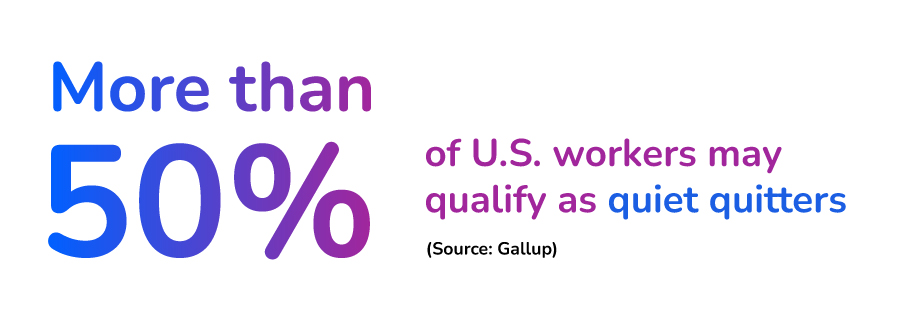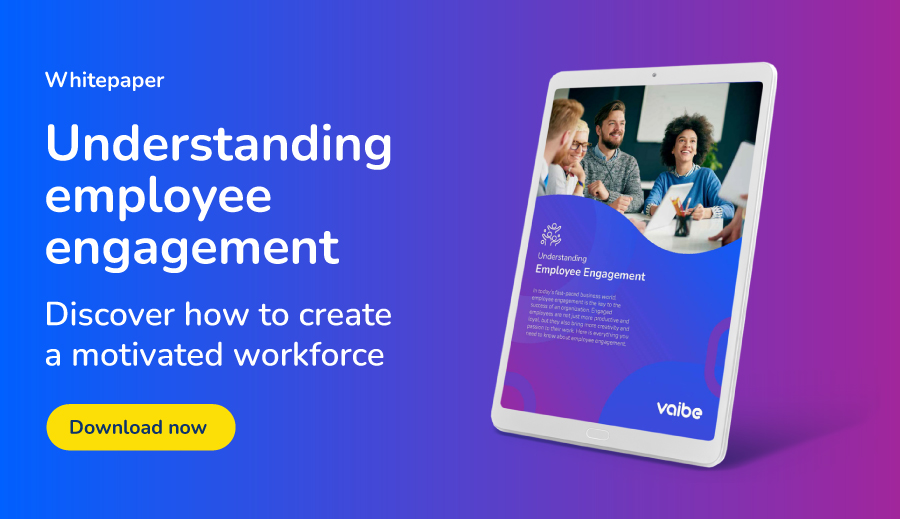You’re probably no stranger to the expression “quiet quitting”. But do you really know what it means? Discover more about this new workplace trend and how gamification might be the antidote for it.

Back to Blog
Workplace trends are all over social media. From “rage applying” to “job shift shock”, younger generations are using TikTok and Instagram to share their work experiences. By doing that, they create movements that inspire other workers to shift their attitude towards office life. Among these trends, there’s one that’s making leaders and teams around the world pause and think: quiet quitting.
If you’ve never heard of quiet quitting before, you’re probably thinking about turnover rates and notice periods. But this isn’t about employees storming out the door. It’s about them staying but silently disconnecting.
The impact of quiet quitting can be just as damaging as actual resignations. Left unchecked, quiet quitting chips away at morale, culture, and business performance.
So, what exactly is quiet quitting? Why should you address it, and how can you tackle it head-on? Let’s break it down.
“Quiet quitting”, sometimes described as “silent resignation,” went viral on TikTok in 2022. The term describes employees that stop going above and beyond. Instead, they do the bare minimum required, showing up physically but checking out emotionally.
The telling signs
It’s easy for quiet quitting behaviors can go under the radar within an organization. However, there are subtle signs which indicate that the phenomenon might be happening:
The concept of quiet quitting isn’t brand new. Some trace its roots to China’s “lying flat” movement, while others point to corporate circles as early as 2009. But it goes way back. In the 1999 movie “Office Space,” the main character, Peter Gibbons, works for the classic corporation archetype and has a line where he presents the concept:
-
Movie trivia aside, one thing is certain: Gallup reports that more than 50% of U.S. workers may qualify as quiet quitters. And that’s a number no business can afford to ignore.
Also according to Gallup, there’s a direct link between quiet quitting and employees who are “not engaged”. Even though they’re not actually disengaged, they don’t feel a real connection to their work, ending up as underperformers.
This shows us what? Maybe the solution to dealing with quiet quitting is creating more engaged workforces.
Despite being an old concept, it’s mainly the younger generations that are rebelling against the established idea that in order to succeed, you must give 110%. They are not only looking for a well-balanced work-life where they have more time available to spend on hobbies or with their loved ones. No. They decided that the word “workaholic” must be banished from dictionaries worldwide and thrown into oblivion, forever.

Quiet quitting goes beyond social media trends. If it spreads within your workforce like a bad rumor, the ripple effects can be profound. Addressing it quickly is essential for long-term business health. Here’s why:
Preserve talent – When employees disengage, you risk losing not just people but years of knowledge, training, and experience. Retaining them means protecting the intellectual capital that keeps your business competitive.
Boost culture – A workplace thrives when employees feel seen, valued, and connected to the mission. Tackling quiet quitting helps create a culture where contribution is celebrated and collaboration comes naturally.
Enhance productivity – Employees who are motivated and engaged bring energy and initiative. They’re more likely to go the extra mile, solve problems creatively, and deliver results that drive success.
Save costs – Hiring replacements is expensive – recruitment, onboarding, and training all drain resources. Preventing disengagement helps you avoid that financial burden and focus those resources on innovation and growth.
Protect morale – Disengagement is contagious. When a few team members pull back, others may follow. Addressing it early keeps motivation high and prevents negativity from spreading across the organization.
Enable growth – Businesses grow when employees are invested in the future. Committed team members don’t just do their jobs – they actively push the company forward, unlocking new opportunities and sustaining momentum.

Put simply, when employees are engaged and motivated, they thrive. And if they thrive, organizations thrive.
According to Gallup, organizations with highly engaged workforces are 23% more profitable and see their revenue increase 2.5 times. On the other hand, employee disengagement is costing the global economy an astounding expense of $8.8 trillion. This data shows us that engagement matters, and quiet quitting should not be overlooked.
So, how can you re-engage employees before their motivations fade away and they quietly quit? The answer may be simpler than you think.
Gamification integrates game-like elements such as points, badges, leaderboards, and challenges into daily work. Far from being gimmicky, it taps into core human needs: achievement, recognition, and a sense of belonging.
Research backs it up: 89% of employees report feeling happier at work when gamification is applied, while 69% say they’d stay longer than three years if their employer used gamification strategies.
Gamification works because it taps into what truly motivates people. Let’s see some main factors to take into consideration.
Recognition made fun: Celebrating wins in real time with meaningful rewards reinforces positive behavior.
A spark of competition: Leaderboards and challenges add excitement, turning routine tasks into opportunities to get accomplishments seen and recognized.
Collaboration, amplified: Shared goals and group achievements turn teamwork into a game more people want to play together.
Visible progress: When employees can track their own advancement, growth feels tangible and rewarding.
A culture shift: Over time, gamification creates an engaging, supportive workplace where work feels less like.
By transforming repetitive tasks into interactive challenges, gamification keeps employees emotionally connected to their work. It fosters both engagement and loyalty – two of the main components of the antidote that quiet quitting can’t withstand.
Want to see gamification in action? We can help you!
At vaibe, we specialize in helping organizations transform disengagement into motivation. Our white-label gamification solution is designed to strengthen employee engagement, improve performance and productivity, and reduce turnover, by making work meaningful and fun.
Let’s design a gamified workplace that keeps teams engaged, loyal, and ready to perform at their best.
Book a demo today and discover how vaibe can power employee engagement strategies!
Can gamification really transform remote work and help companies keep their teams motivated?
More than liking a job, organizational commitment relates to the intrinsic bond an employee feels towards their company.
Discover how gamification helps boost mental health, reduce stress, and build engagement at work.
Dive into every stage of effective gamification implementation! Elevate your workplace with step-by-step instructions created by our specialists.